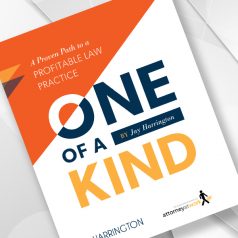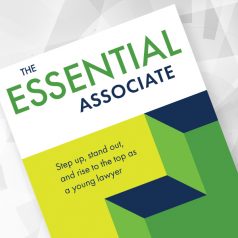Thought leadership content is what sells a lawyer when she’s not there to sell herself. Without a robust digital footprint, a lawyer will be virtually invisible to the increasingly large pool of prospects who rely on Google and social media to find solutions to their problems and winnow down their options.
Your thought leadership content acts as your agent — a public signal of your expertise amid all the noise online. And one of the best tools you can use to bolster your status as a thought leader is LinkedIn.
Use LinkedIn to Hone Your Thought Leadership Content
1. Beta-Test Your Content
There is a compounding return on effort from thought leadership marketing. The more content you share, the more awareness you generate. And the more valuable the content is, the more trust is established. But there’s only so much time in the day, and busy lawyers can’t afford to spend time writing long thought leadership articles that no one reads.
To get a better sense of whether your articles will get the traction and reaction you want, first use LinkedIn to beta-test your ideas. Instead of a 1,500-word article, start with a 200-word (1,300 characters) “post” on LinkedIn.
Studies suggest that in today’s attention-starved world, people read, on average, only 20% of an article and skim the rest. Accordingly, it’s critical to focus on one key idea in every article you write. Beta-testing those ideas through the character constraints imposed by LinkedIn posts will give you some objective feedback about which ideas resonate.
If a post generates lots of likes, comments and shares, you’ll have a pretty good sense that your idea is worth expanding into a longer article. If there’s little to no engagement, it’s a strong signal that you need to either refine the idea or possibly move on.
2. Learn What Your Clients Are Interested In
Ideas are the lifeblood of effective thought leadership marketing. And the best source of good ideas is the audience you hope to serve. A great way to source good ideas is by paying attention to the content and comments generated by those in your ideal-client audience on LinkedIn. What questions are being asked? What trends are being discussed? By paying attention to the “water-cooler” discussions among those in and around the markets you serve (often called “social listening”), you gain valuable insights that can inform your own content efforts.
3. Cultivate New Business Opportunities Through Collaborative Thought Leadership Marketing
Thought leadership marketing is effective because it introduces your ideas and insights to audiences at scale and allows you to position yourself as an expert to prospective clients. Often overlooked is that the process of creating thought leadership content can be an effective one-on-one business development tactic. By collaborating with prospective clients to create such content, you can create new relationships and deepen existing ones.
Examples of collaborative thought leadership marketing include:
- Co-authoring an article with a general counsel.
- Doing co-branded market research with a consulting firm that is a referral source.
- Organizing a panel discussion.
- Inviting a prospective client to appear as a guest on your podcast.
No one likes to be “pitched” on LinkedIn. However, inviting a member of your LinkedIn network to collaborate on a thought leadership project is not a pitch — it’s a way to offer something of value. Whether or not your prospective collaborator accepts your invitation, they will appreciate it and you’ll be on their radar.
4. Establish Editorial Relationships for Off-Site Publishing Opportunities
Lawyers often default to publishing all the thought leadership content they write on their firm’s website. Instead, look for more opportunities to publish off-site on third-party platforms. Executives, entrepreneurs and other consumers of legal services are busy. When they spend time online, they’re visiting sites they know, like and trust.
By understanding where members of your target market consume their information, you can seek to publish there. When your byline and a link back to your website appear on a platform that the audience you’re trying to reach already trusts, you can leverage the credibility that those platforms already have with their audience.
The problem is that most lawyers don’t have relationships with editors who are the gatekeepers of valuable off-site publishing opportunities. LinkedIn is the best place to establish those relationships. By connecting with the editors and reporters at publications you hope to write for, you’re a few steps away from the opportunities you desire. The interim steps involve creating and sharing thought leadership content on LinkedIn that editors and reporters will be exposed to.
Every industry has publications — from trade journals to websites — that are well-regarded but often operate on a shoestring budget. As a result, many are starved for quality content to share with their audiences. If the content you share on LinkedIn catches the eye of editors and reporters at those publications, they’ll be more likely to reach out to you with guest-posting opportunities or requests to interview you based on your subject matter expertise.
LinkedIn is much more than a place to passively network or look for a new job.
It’s the place thought leaders cultivate meaningful relationships and curate great ideas that take their content to the next level.
More Thought Leadership Tips on Attorney at Work
“How to Create LinkedIn Content That Resonates With Your Audience”
“How to Become a Thought Leader”
Illustration ©iStockPhoto.com
BUSINESS DEVELOPMENT RESOURCES
One of a Kind: A Proven Path to a Profitable Law Practice. In this popular book — part marketing theory, part how-to — attorney, coach and legal marketing expert Jay Harrington teaches how to harness your creativity to develop a profitable niche practice, build your personal brand, increase your visibility, and become a prolific, effective content marketer. Jay draws on his own experience, as well as the experience of successful attorneys who have used the strategies and tactics recommended in the book.
The Essential Associate: Step Up, Stand Out, and Rise to the Top as a Young Lawyer, by Jay Harrington, is for young lawyers who aspire to grow, succeed and advance on a partnership track at a law firm. Jay’s practical, step-by-step guide is aimed at helping new lawyers thrive in today’s competitive law firm environment. It includes insights from dozens of successful lawyers at firms across the country, general counsel at Fortune 500 companies, and top consultants to the legal industry.



















